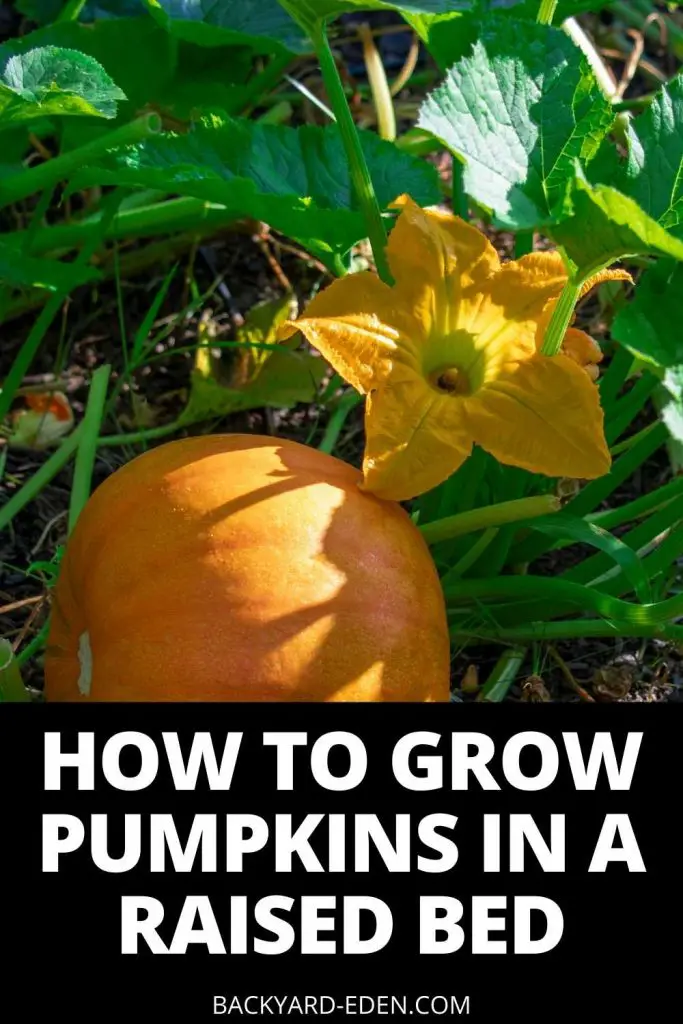How to Grow Pumpkins in a Raised Bed
If you’re looking for an easy way to grow your own pumpkins, a raised bed is the way to go! In this step-by-step guide, we will show you how to plant and care for your pumpkin plants in a raised bed.
By following these simple instructions, you can have a bountiful harvest of delicious pumpkins this fall!
Are Pumpkins Easy To Grow?
Pumpkins are some of the easiest plants to grow, especially if you start with a quality seed. These hearty fruits can withstand a range of conditions, from droughts and heat waves to heavy rains and occasional frost.
Their hardy nature means that you don’t need to worry about over-watering or under-watering them, and they can produce an impressive bounty of fruit even in climates that are less than ideal for growing anything.
To ensure the best chances of a successful pumpkin crop, choose healthy seeds to start with and give your plants plenty of sunlight, room to grow, and well-drained soil with plenty of organic material added.
With just a little bit of TLC, you’ll soon be harvesting your very own pumpkins! So go ahead – plant those seeds today and experience the joys of having your very own pumpkin patch! You won’t regret it.
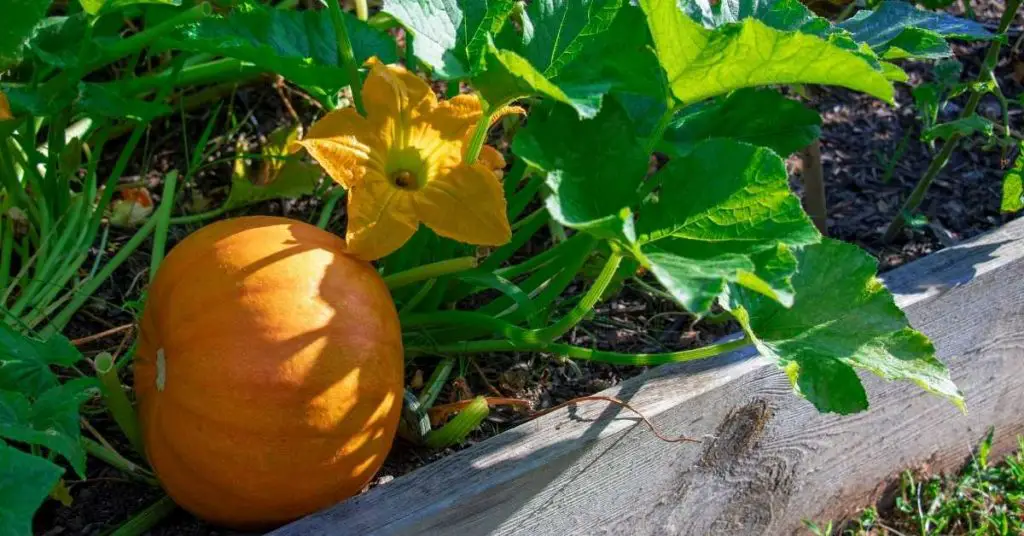
How Many Pumpkins Will One Plant Produce?
It depends on the variety of pumpkins, most plants can yield anywhere from 3 to 10 pumpkins. So, if you’re hoping to carve a few jack-o-lanterns this year, be sure to plan accordingly!
Of course, not all pumpkins are created equal. Some varieties are better suited for pies or other desserts, while others are simply too small to be carved.
But whether you’re looking for the perfect pumpkin pie or the biggest jack-o-lantern on the block, there’s sure to be a pumpkin out there that’s just right for you.
How to Grow Pumpkins from Seed
Growing pumpkins from seed is a great way to get into gardening, and it’s also a fun way to add some flare to your autumn landscape.
Whether you’re growing your pumpkins from seed for ornamental purposes or for use in fall baking, there are a few tips that can help ensure success.
How to Germinate Pumpkin Seeds
One of the most satisfying things about growing pumpkins is watching the little seeds germinate and grow into healthy plants.
Here are some tips on how to germinate pumpkin seeds so you can enjoy a bountiful crop come autumn.
The first step is to start with fresh, viable pumpkin seeds. If you’re using seeds from last year’s Halloween jack-o-lantern, give them a quick rinse to remove any lingering pulp.
Then, place the seeds in a bowl of warm water and let them soak for 24 hours. This will help to soften the seed coat and encourage germination.
Next, fill a planting tray or pot with moistened potting mix. Make sure the mix is loose and airy, as pumpkin roots need room to grow.
Then, plant the seeds about 1 inch deep in the soil. Be sure to keep the soil moist but not soggy, as too much water can cause the seeds to rot.
Finally, place the tray or pot in a warm location out of direct sunlight and wait for the seeds to germinate.
In just a few days, you should see little green sprouts poking through the soil!
Once the seeds have germinated, it’s time to transplant them into your raised bed. Be sure to wait until all danger of frost has passed and the soil is warm before planting.
Pumpkins are heat-loving plants, so they won’t do well if transplanted too early in the season.
Also, keep in mind that you can sow pumpkin seeds directly into your raised bed by picking a spot and placing the seeds about 1/2 inch below the surface. Cover with soil and water them in.
How to Plant Pumpkins in a Raised Bed
Pumpkins are best suited for planting in raised beds, as they need plenty of room to spread out and their roots benefit from the extra drainage that raised beds provide.
If you’re starting with seedlings, transplant them into the bed when they are about 12 inches tall. If you’re planting directly from seed, sow the seeds in hills that are about 12 inches apart.
Once the plants are in the bed, water them well and add a layer of mulch to help retain moisture. Then, all you need to do is sit back and wait for the pumpkins to grow!
Fertilize the plants every few weeks with a high-quality organic fertilizer to ensure they have all the nutrients they need to produce a bountiful crop.
Taking Care of Pumpkin Seedlings
When it comes to taking care of pumpkin seedlings in your raised bed you need to make sure to keep them watered and fertilized throughout the season as pumpkins are heavy feeders.
What Month Do You Plant Pumpkins?
Pumpkins should be planted during spring in most locations. You can start pumpkins from seed indoors or in a greenhouse about 4 weeks before your last frost date.
Or You can direct sow pumpkin seeds into your bed 1 week or so before your last frost.
When it comes to planting your seedlings that you have started from seed or ones you may have picked up at your local nursery, you can plant those after all danger of frost has passed.
You can also stagger the plantings so you do not have a ton of pumpkins ready at the same time.
Just keep in mind the number of days that your seed packet says on the back that your plant will need to reach maturity and produce fruit.
If the packet says 100 days, it is telling you that it will take 100 days from when you plant your plant into the ground. In other words, 100 days from transplant and approximately 120-30 days from seed.
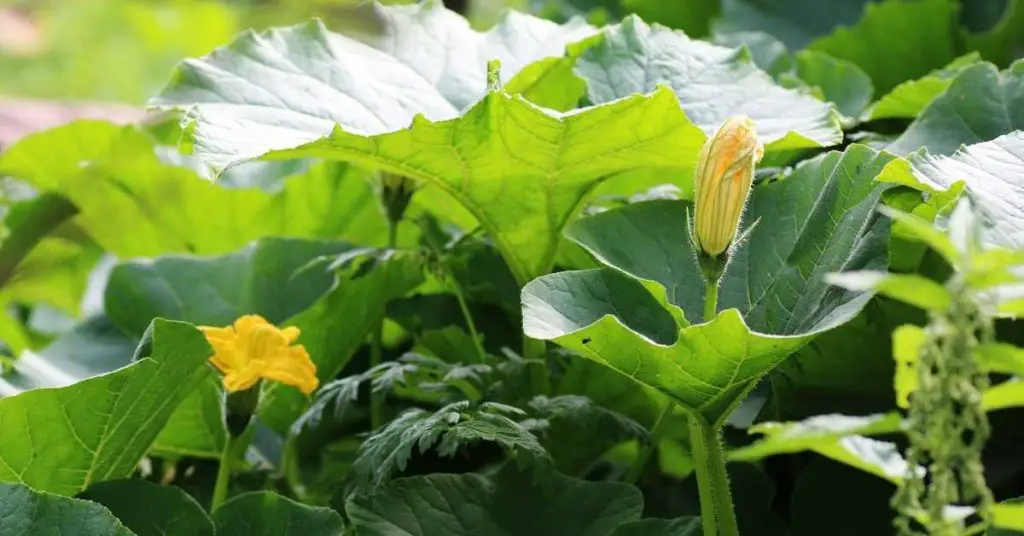
Do Pumpkins Like Sun or Shade?
Pumpkins like full sun so plant them in a raised bed that gets at least 4-6 hours of sun each day but they can even stand 6-8 hours of full sun a day.
Do not be alarmed if your pumpkin leaves wilt during the hottest part of the day as pumpkins and other cucurbits (melons, cucumbers, squash, etc) will wilt during those times as a way to conserve water.
Once this part of the day has passed, they will perk back up. I do however recommend regular watering using either a drip irrigation system or just watering them with the hose.
If you live in an area where powdery or downy mildew is a big problem then water your plants deeply once per week.
If you live in an extremely hot climate like we do in Texas where you can reach triple digits during the summer, you can also use straw or even shredded leaves to mulch your raised bed to help retain some moisture.
How Much Space Does a Pumpkin Plant Need?
Pumpkin plants are monsters when it comes to the overall space they will take up in a raised bed or a yard for that matter. One plant will easily take up an entire raised bed and encroach onto your lawn if you are not careful.
I recommend giving a pumpkin plant at least 4 square feet if you are growing them in a raised bed with limited space. You could even grow pumpkins vertically if you want to save some space.
In fact, the very first year that I grew a garden, I grew pumpkins that took over my yard. I planted them in a traditional in-ground garden that uses rows and the plants spread all throughout the garden and into about a 1/3 of my backyard.
The best thing to do is to plant your pumpkins on the edge of your raised bed and trained them out into your yard in an area that you choose. You can do this with a little work each day or even week by just directing the growing vines where you want them to go.
If you missed a few days of doing this the ever-growing vine will put down roots at each leaf node so when you go to move them you will be uprooting a portion of your plant.
Do Pumpkins Have Deep Roots?
Although these garden monsters can take over your garden and beat up on your other plants, they have root systems that will extend down into the moist soil in search of nutrients.
You should plant your pumpkins where they will have at least 12 inches of soil to keep them happy and healthy.
If you are choosing to grow pumpkins in containers, choose a container that is at least 12-18 deep so your pumpkin can establish a good root system.
How Deep Should Raised Beds Be for Pumpkins?
A raised bed should be at least 12 inches deep but can be as deep as you want them to be for pumpkins. On the other hand, this does not mean that you cannot grow pumpkins in shallower beds if you do some work to prepare them for the pumpkin plants.
You can always double dig to loosen the soil below your raised bed which essentially adds that much more depth to the bed.
How Do You Prepare the Soil for Pumpkins?
You can prepare the soil in late winter or early spring. Pumpkins need a lot of space to grow, so make sure to choose a spot that is at least four feet square.
Amend your raised bed soil with 2-3 inches of high-quality compost or manure to provide nutrients, and make sure it drains well.
The compost will feed your plants over the course of the season and help suppress weeds.
What Can I Plant with Pumpkins?
When it comes to planting pumpkins, there are a lot of options for what you can grow alongside them. For example, you might choose to plant flowers like marigolds or sunflowers that can help to draw beneficial insects to your garden.
You could also add some quick-growing leafy greens like lettuce or spinach, which will get established and you can even start harvesting before the heavy vines of the pumpkins get established.
Finally, if you are looking for something with a bit more color, why not try planting zinnias or dahlias near your pumpkin plants?
These will add a nice pop of color to your raised bed that you can enjoy all season alongside your massive pumpkin plants.
With so many great choices for companion plants, it’s easy to create a dynamic and thriving garden full of beautiful fall colors.
So why not start planning today? After all, pumpkins are nothing without their awesome companions!
How Often to Water Pumpkin Plants
Pumpkin plants need a lot of water to grow and flourish, but it can be tricky to know how often to water them. Generally, you should try to provide your pumpkin plants with at least one inch of water per week.
In addition, it is important to watch out for signs of too much or too little water in the soil. For example, if the leaves start to turn yellow and wilt, you likely need to increase your watering routine.
Alternatively, if the leaves show brown spots or crinkled edges, then you’re probably watering too much and need to back off a little bit.
Ultimately, optimal watering depends on a number of different factors such as temperature and soil type.
So if you want healthy pumpkin plants that yield delicious fruits to come harvest time, be sure to get your watering routine just right!
What Is the Best Fertilizer for Pumpkins?
There are three ways to approach fertilizing your pumpkins so choose the one that fits your needs:
Compost
Compost is an all-natural, super-rich fertilizer that is full of microbes that will help your plant grow and produce great pumpkins.
You can always just top off your raised bed with 2-3 inches when you prepare the bed for planting your pumpkins and then side dress with more compost during the season a couple of times.
Compost will provide the nutrients that your growing pumpkins will need.
Granular Fertilizer
The best fertilizer for pumpkins is one that is high in nitrogen and phosphorus. Nitrogen helps the plant to produce more leaves, while phosphorus helps to promote fruit development.
A good pumpkin fertilizer will also contain other essential nutrients, such as potassium and magnesium.
Apply the granular fertilizer to the soil around the base of the plant once every two weeks and cover it with soil during the growing season.
Be sure to follow the instructions on the product label to avoid over-fertilizing, which can damage the plant.
Liquid Fertilizer
You can water your pumpkin plants with a water-soluble fertilizer once every 7 to 10 days by following the instructions on the package. This can be a fish emulsion, fish and seaweed fertilizer, or even organic water-soluble fertilizer.
With a little TLC, your pumpkins will thrive and produce an abundance of delicious fruits!
How Often Should I Fertilize Pumpkins
Pumpkins are heavy feeders so you should fertilize them once every 7 to 10 days depending on the type of fertilizer you choose to use.
Pumpkin Flowers and Fruit Production
Once the pumpkin plants have grown for a while they will start to produce flowers. Typically, the plant will produce male flowers first which is a flower with a long stem.
These male flowers will open up in the morning and usually close up the same day.
I find that it is very important to hand pollinate these male flowers with your finger or a q-tip even if you are just going to each male flower and swabbing them. This will essentially be a signal to the plant to let them know that there are pollinators nearby.
This helps the plant along to start producing female flowers. The female flower will be a flower with a baby pumpkin starting to form right behind the flower on the stem.
This is only on the female flower and is an easy way to tell whether a flower is male or female.
If you do not notice any bees coming around your garden you should continue to hand pollinate your pumpkin flowers by using a q-tip.
You should swab a male flower well and then move along to however many female flowers you have opened.
Make sure you check your flowers each day as new female flowers will open in the morning as the males do and will close up later that day.
After pollination, if you have been successful you will begin to see those baby pumpkins start to grow in size, and boy do they grow.
Once your pumpkins are growing and on their way, you should be able to harvest them anywhere from 80 to 130 days depending on the variety.
Pro Tip: If you are wanting to harvest a massive pumpkin, pick which one or two you want to grow out, and then you can remove any other pumpkins that may be forming. This will allow the plant to focus on those pumpkins that are already growing thus making them larger. This is what the giant pumpkin growers do to get those massive results. Good luck!
If for some reason you notice that they do not grow or even develop a dark, almost black spot on the fruit, you were likely unsuccessful in your pollination attempts.
If you feel like you aren’t doing a good job using the q-tip, you can even snip off the male flowers, peel back the petals and use the flower itself to hand pollinate the female flowers. That should increase your chances.
Should You Turn Pumpkins as They Grow?
Yes, you should turn your pumpkins as they grow. This should be done very carefully so that you do not break or hurt the stem. If you break the stem or damage it in any way you will most likely lose that pumpkin.
What to Put Under Growing Pumpkins?
In order to harvest the best-looking pumpkins, you should put either a piece of regular cardboard or even newspaper under your growing pumpkins to prevent any damage from the pumpkin touching the soil.
Touching the soil can cause your pumpkin and other produce to rot over the course of the season.
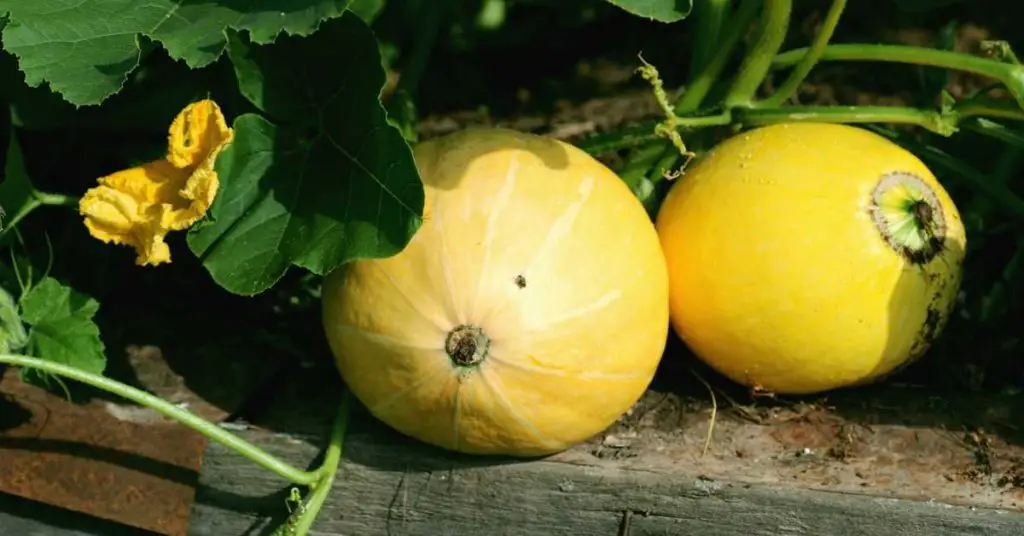
Common Pumpkin Pests
Pumpkins are a popular and delicious fall crop that is prone to a number of different pests.
Some of the most common pumpkin pests include:
Vine borers are long, thin worms that burrow into the main stem of the pumpkin plant, causing it to wilt and eventually die.
Cucumber beetles are small insects with black and yellow stripes that attack the leaves of the plant and leave round holes in them.
Aphids are tiny bugs that feed on pumpkin leaves, resulting in distorted growth and yellowing foliage.
Whiteflies tend to flock to pumpkins in massive numbers, forming thick clouds around plants and spreading damaging viruses as they move from one plant to another.
Luckily, there are many ways to control these common pumpkin pests with organic pesticides and other methods.
Whether you choose chemical sprays or more natural solutions like garlic tea or soap spray, keeping your pumpkins pest-free is key to ensuring their continued health and vitality!
Frequently Asked Questions (FAQs)
Here are some commonly asked questions about growing pumpkins in raised beds:
Are Pumpkins Green at First?
Yes, pumpkins start out their life green and slowly turn their color over the course of the growing season as they ripen. It sounds and even looks weird to see a green pumpkin but given enough time they will ripen up.
Can You Grow Pumpkin on A Trellis?
Yes, you can grow pumpkins vertically using a trellis. If you plan on growing pumpkins vertically and using a trellis to support them, it is best if you choose a small-fruited variety such as Jack Be Little or Jill Be Little.
These are smaller varieties that will work great growing them in a pot or on a trellis.
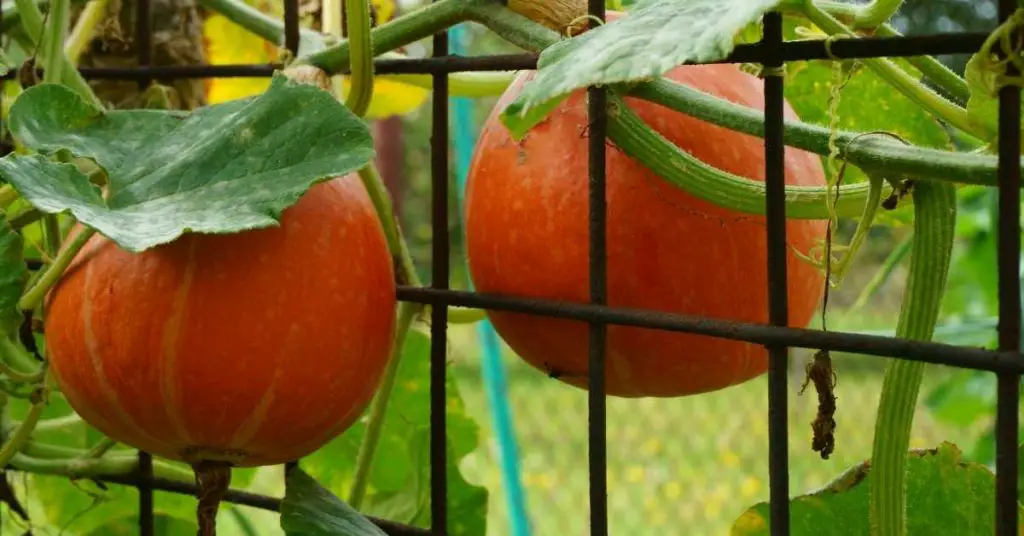
In Conclusion
Now that you know how to grow pumpkins in a raised bed, it’s time to get planting! Follow the step-by-step guide above and you’ll be on your way to enjoying a delicious pumpkin harvest this fall.
Be sure to keep an eye out for common pests and take steps to control them using organic pesticides or other methods. Happy pumpkin growing!
